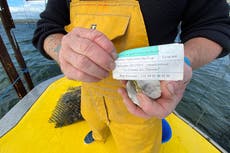What to know about eating raw oysters safely
Oysters that contain Vibrio do not ‘look, smell, or even taste different from any other oyster,’ CDC states
Three people in the New York area have reportedly died after contracting infections from a flesh-eating bacteria that can be caught by eating raw oysters or swimming in the ocean, according to health officials.
Officials said one person died in Suffolk County on Long Island, while two other victims were from Connecticut.
According to the Centers for Disease Control and Prevention (CDC), eating raw oysters and any undercooked fish can put you at risk of infection with Vibrio, a type of bacteria that “naturally inhabit[s] [in] coastal waters where oysters live”.
Eating raw oysters can cause Vibrio vulnificus, a condition that can lead to severe illness like “bloodstream infections and severe blistering skin lesions”. The agency also notes that Vibrio vulnificus infections can not only “require intensive care or limb amputations,” but “15 to 30 per cent” of them can result in death. According to the CDC, Vibrio infections can be mild, however, the bacteria can be fatal for those who have liver disease or weakened immune systems.
The CDC estimates that approximately “80,000 people get vibriosis - and 100 people die from it - in the United States every year”. Although most illnesses occur during the warmer months, such as May through October, the CDC notes that you can still get sick from eating raw oysters during any season.
However, according to the agency, it is unfortunately “impossible” to tell if an oyster is bad just by “looking at it,” as it can “contain harmful bacteria [that] doesn’t look, smell, or even taste different from any other oyster”.
With that in mind, there are multiple ways to keep yourself safe from getting an infection due to consuming oysters. For example, when touching raw fish, you should always cover up any recent wounds, including those from a piercing, tattoo, or surgery.
“Cover any wounds if they could touch raw seafood or raw seafood juices, or if you might come into contact with brackish or salt water,” the CDC writes.
Along with not eating fish that is undercooked, the CDC recommends keeping your cooked and uncooked seafood separated in order to avoid cross contamination.
When cooking shellfish in the shell, you should either boil it “until the shells open and continue boiling another three to five minutes” or add it to a steamer “when water is already steaming and cook for four to nine minutes”.
The CDC also notes that you should “only eat shellfish that open during cooking” and “throw out any shellfish that do not open fully after cooking”. If you notice any shellfish with open shells before cooking, those should be discarded as well.
For shucked oysters, some safe cooking tips include boiling them “for at least three minutes,” frying them with oil “for at least three minutes at 375 F”, and baking “at 450 F for 10 minutes”.
According to the US Food and Drug Administration (FDA), “nothing but prolonged exposure to heat at a high enough temperature will kill bacteria” in shellfish that is contaminated.
The FDA also notes that the belief that consuming just a few contaminated oysters will not hurt you is not true, as there has been a reported fatality from eating just three oysters. “The seriousness of any case depends on many factors, including how much bacteria is ingested and the person’s underlying health conditions,” the agency states.
Join our commenting forum
Join thought-provoking conversations, follow other Independent readers and see their replies
Comments


Bookmark popover
Removed from bookmarks